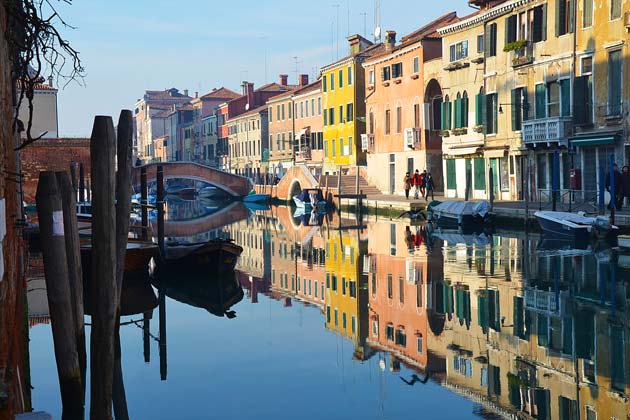(with a brief shout-out to the humble anchovy)
For anyone who knows New York’s Lower East side, a visit to Venice’s Ghetto is an oddly familiar experience. At least that’s the way it felt to me when I first crossed the Guglie bridge, the neighborhood’s main entry point, some twenty years ago. I was living in the Lower East Side at the time and wandering among the Ghetto’s narrow alleys with their tall, teetering tenements made me feel oddly at home. Because the Jews of Venice had been denied the right to live elsewhere in the renaissance port town, they had to build up—four, five, six stories—and lacking the money to cover the brick walls with marble they left them plain. (This was the original so-called “ghetto”, from the Venetian dialect geto or foundry.) All that was missing here to make me feel totally at home was the fire escapes and the hard-edged mumble of New York accents.
In the intervening years they haven’t installed any fire escapes but weirdly enough, the accents are now there. It’s hard to visit the Ghetto these days without running across a Lubavitcher angling for a catch. “Are you Jewish?” he asks with the thickest Brooklyn accent. It isn’t the accent that bothers me—after all Venice always used to be a hubbub of the world’s languages. No, the problem here, as elsewhere in Venice, is that all the foreign accents come from tourists. Just like them, the young man from Brooklyn is just passing through. There are no locals, or too few at any rate to maintain any tradition.
And did I really need to come to Venice to eat matzo ball soup and shwarma? You can order both of them at the Gam Gam Kosher Restaurant, right off the Guglie bridge. As far as the Venetian food goes, the menu contains little more than a couple of half-hearted nods to local tradition. Most of the food is Israeli. Again, this absence of local dishes is not specific to the Ghetto. In the streets off of San Marco, you are more likely to find pizza by the slice (like the matzo ball soup, another New York import) than a briny dish of bigoli in salsa. Which finally brings me to the subject of this column.
Bigoli is a rough sort of whole-wheat spaghetti and the salsa is most typically a slow cooked amalgam of onions and anchovies cooked in plenty of olive oil until it all turns into a intensely sweet and salty puree. The whole wheat-pasta is the perfect counterpoint. There are variants that use salt-preserved sardines and even tuna. And there is also a Jewish variant, where garlic is used instead of the onions. Why the substitution? One explanation may lie with the fact the many of Venice’s Jews migrated here from other parts of Italy or Spain where garlic is much more in favor than in relatively garlic-shy Venice. But I think there is an even more cultural explanation.
Italian Jews, much like the Diaspora everywhere, have always adapted the local culinary culture to suit their purposes. Witness the numerous slow-cooked dishes for the Shabbat, whether from Poland or Morocco. Or the 101 kinds of fritters that were dreamed up in Cochin, Berlin or Istanbul to celebrate Chanukah. In Italy—not surprisingly—Jews eat pasta: pasta with meat sauce, pasta with eggplant, pasta with—well, you name it. But the one thing that you find commonly in the repertoire of gli Ebrei, that hardly ever shows up on the gentile menu is pasta salad. As a rule, Catholic Italians eat their pasta warm (though this is changing of late).
But what if you are not only a good Jew but also a good Italian, and thus need to serve pasta as a first course for the usual multi course Saturday lunch? The obvious solution is pasta salad, or to be more accurate, a pasta dish served at room temperature. Which is why I think the Jewish variant of bigoli uses garlic. Because slow-cooked garlic is incomparably superior to onions at room temperature. Made with garlic, bigoli in salsa can be made hours, even a day ahead, and served cool. It’s a heritage worth holding on to. And need I point out that this cool pasta tradition is as applicable to the shady canyons of Venice’s Ghetto as it is for canyons of West L.A.?
Michael Krondl is a chef, artist and culinary historian. His most recent book is The Taste of Conquest: The Rise and Fall of the Three Great Cities of Spice.
The words of this author reflect his/her own opinions and do not necessarily represent the official position of the Orthodox Union.

